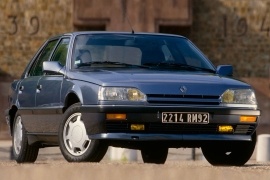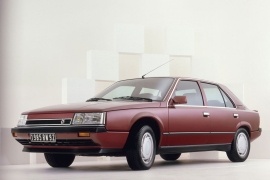RENAULT 25 Models/Series Timeline, Specifications & Photos
First production year: 1984
Engines: Gasoline, Diesel
Body style: Hatchback
It was the last stint for Renault's flagship model, the 25, a car that appeared on the market in 1982, and after six years, it started to show its age.
Unlike other automakers who thought that an executive vehicle should be a three-box sedan vehicle, Renault considered that a two-and-a-half shape would do just fine or even better. It was wrong, but the French company didn't want to change that.
For the refreshed version, Renault managed to apply a consistent change to the car's look. Thus, the headlights were no longer just simple, rectangular headlamps. They sported an angled-down inner side that merged towards the one-slat thin grille. Moreover, the car's profile looked more refined thanks to the body-colored flush door handles and matching door mirrors. In addition, depending on the trim level, a chromed line adorned the rubber strips mounted on the door panels, the fenders, and the bumpers.
The interior looked very different from other automakers. In front of the driver, Renault placed an instrument cluster that looked like a command and control panel with various buttons on its left and an upper visor that protected them from sunlight. In addition, on the center stack, the automaker placed a slanted panel for the audio controls. The comfortable bucket seats at the front were made for long travels, while the rear bench was good enough for two passengers. Also, the bench sported a split-folding mechanism that extended the trunk's size when needed.
Under the hood, Renault ditched all the carbureted engines and installed only fuel-injected ones. In addition, apart from the mundane 2.0-liter powerplants, it added the smooth and revised PRV engine or a punchy 2.5-liter turbocharged unit. For those concerned about fuel efficiency, Renault offered a choice of two sluggish diesel units.
The 1984 Renault 25 was the successor for the Renault 20/30 model and it was a true luxury French car. Even if it wasn't a three-box sedan, it was recognized as one of the most comfortable cars from its segment.
After nine years on the market, the Renault 20 had to be retired. It was good for its days but it already started to show its age. Convinced by the successful Renault 16, the French management decided to build the 25 as a hatchback, but with the rear end to mimic a sedan. For that, they hired some prestigious designers for the exterior. Robert Opron (who designed the Citroen SM and Renault Alpine) and Marcello Gandini (Lamborghini Countach, Lancia Stratos) for the interior.
The result was a two and a half box design, with a long roofline. The overall square design of the car was in trend of those times. The grille was made from thin horizontal lines. The plastic bumpers were already a constant presence on the cars and that allowed a lower apron for aerodynamic purposes. In the back, the horizontal taillights were big and visible.
The 25 was offered with luxury features such as leather seats, automatic transmission, and air-conditioning. The front seats were large and comfortable, while the rear seats offered decent headroom and legroom due to its long, 2.72m (107.1”) wheelbase. The large trunk could have been extended by folding the rear bench seatback.
The Renault 25 was offered with both gasoline and diesel engines. The standard gearbox was a 5-speed manual, while a 4-speed automatic was available as an option for specific models. Unfortunately, its front-wheel-drive architecture didn't make it a winner against the German cars.

